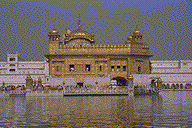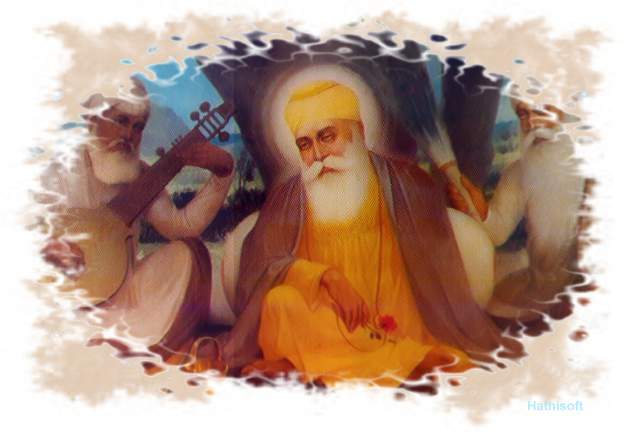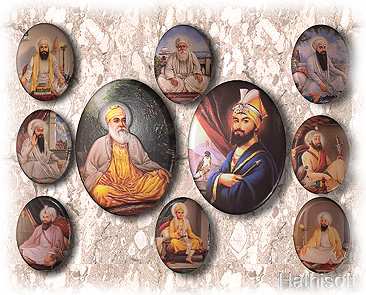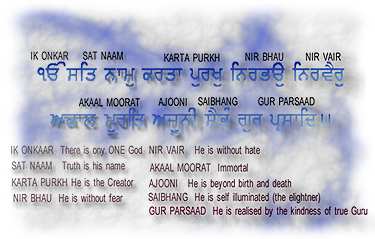Philosophy of Religion
Chapter 2. Religions of the World
Section 12 . Sikhism





You should read enough of the materials presented in this section concerning the tradition of Sikhism in order to understand how this tradition displays the characteristics or elements that make a tradition one that would be termed a “religion. The tradition presented in the materials below is one of the world’s living religions. You reading should indicate why this is so.
· THE ABSOLUTE: what do the believers hold as most important? What is the ultimate source of value and significance? For many, but not all religions, this is given some form of agency and portrayed as a deity (deities). It might be a concept or ideal as well as a figure.
· THE WORLD: What does the belief system say about the world? Its origin? its relation to the Absolute? Its future?
· HUMANS: Where do they come from? How do they fit into the general scheme of things? What is their destiny or future?
· THE PROBLEM FOR HUMANS: What is the principle problem for humans that they must learn to deal with and solve?
· THE SOLUTION FOR HUMANS: How are humans to solve or overcome the fundamental problems ?
· COMMUNITY AND ETHICS: What is the moral code as promulgated by the religion? What is the idea of community and how humans are to live with one another?
· AN INTERPRETATION OF HISTORY: Does the religion offer an explanation for events occurring in time? Is there a single linear history with time coming to an end or does time recycle? Is there a plan working itself out in time and detectable in the events of history?
· RITUALS AND SYMBOLS: What are the major rituals, holy days, garments, ceremonies and symbols?
· LIFE AFTER DEATH: What is the explanation given for what occurs after death? Does he religion support a belief in souls or spirits which survive the death of the body? What is the belief in what occurs afterwards? Is there a resurrection of the body? Reincarnation? Dissolution? Extinction?
·
RELATIONSHIP TO OTHER
RELIGIONS: What is the prescribed manner in which believers are to regard
other religions and the followers of other religions?
**********************************************************
For those who wish to listen to information on the world's
religions here is a listing of PODCASTS on RELIGIONS by Cynthia
Eller.
************************************************************
If you have iTunes on your computer just click and you will be led to the
listings.
http://phobos.apple.com/WebObjects/MZStore.woa/wa/viewPodcast?id=117762189&s=143441
Here is a link to the site for the textbook REVEALING WORLD RELIGIONS
related to which these podcasts were made.
http://thinkingstrings.com/Product/WR/index.html
About 2% of India's population are Sikhs. Even so they because of their unique appearance, sometimes stand for India. Traditionally the men keep their hair and do not shave their beard or moustache. They gather their head hair in a turban. Sikhism is comparatively a new religion in India. This religion was established by Guru Nanak. Guru Nanak was born in 1469 in the Punjab region of north India. Guru Nanak was a Hindu and he loved to travel and learn. He developed a new religion and included in it what he thought were the good beliefs of the two dominant religions in the Punjab region, Hinduism and Islam. And Sikhism indeed has beliefs from these two religions. From Islam it adopted the belief in the existence of one invisible God. From Hinduism it adopted the belief in Karma and reincarnation, meaning your actions in this life will decide your fate in the next incarnation. The Sikhs also cremate their dead ones as is done in Hinduism.
The creators of Sikhism tried to abolish some of the Indian customs such as the caste system and Sati - burning of the widow. In Sikhism everyone has equal rights irrespective of caste, creed, color, race, sex or religion. Sikhism rejects pilgrimage, fasting, superstitions and other such rituals. Sikhism does not have a clergy class as it considers this as a gateway to corruption. However they have readers and singers in their temples.
A Sikh place of worship is called Gurdwara. Sikhism does not support pilgrimage to holy sites because according to Sikhism, God is everywhere and not in any certain place. But Sikhism has a few important sites, of which, the Hari Mandir, also known as the 'Golden Temple' in Amritsar in Punjab is the most important site and is considered the holiest shrine of Sikhism.
Sikhism emphasis community services and helping the needy. One of the distinct features of Sikhism is the common kitchen called Langar. In every Gurdwara there is a Langar. Every Sikh is supposed to contribute in preparing the meals in the free kitchen. The meals are served to all and are eaten sitting on the floor and this is to emphasis the point that all are equals. Sikhism does not believe in holding fasts for body is God's present to human being and therefore humans must foster, maintain and preserve it in good sound condition, unless fasting is done to foster the human body like healthy diets.
Guru Nanak who established Sikhism was its first Guru. After him there were nine more Gurus who were the highest religious authority. The last Guru, Guru Gobind Singh, proclaimed that after him the Guru of the Sikhs would be the holy book of Sikhism, Guru Granth Sahib.
Guru Granth Sahib is written in Gurumukhi script. It includes the writings of the Sikh Gurus and the writings of Hindu and Muslims saints. But out of humility Guru Gobind Singh did not include his own writings in the book, which he proclaimed as the permanent Guru of the Sikhs. His writings appear in a separate book called Dasam Granth. Guru Gobind Singh is also the Guru behind the unique appearance of Sikh men.
During Guru Gobind's term as the Guru of the Sikhs and also before him, the ruling empire of Punjab region was the Moghul Empire. The Moghuls were Muslims. Some of the Moghul emperors, like Aurangazeb were fanatic Muslims who harassed the non- Muslims, including the Sikhs. Some of the Guru Sikhs were even executed by the Moghul emperors. In order to stop their persecutions, Guru Gobind decided to make his followers a community of fighters. He changed his surname to Singh, which means lion. His followers also changed their surname to Singh. Since then a ceremony of baptizing was established among the Sikhs in which the boys were given the title Singh and the girls were titled Kaur meaning princess. In those days "Singh" as a surname was very popular among a famous warrior caste of north India, the Rajputs. Some of the first Sikhs were also Rajputs.
In order to make it easier for his followers to recognize each other, Gobind Singh, chose five marks, some of which even today symbolize the Sikhs. The five signs were, uncut hair; comb; sword or dagger; bracelet on the right wrist and shorts. The religious Sikhs dress according to Guru Gobind Singh's order, carrying a sword. Most of the Sikhs even today have uncut hair and gather it in a turban. But some easygoing Sikhs cut their hair or they do not gather their uncut hair in a turban.
The emphasis on militant tradition and community service in Sikhism continues even today and many Sikhs serve in the Indian army or police.
©Aharon Daniel Israel 1999-2000
I. Introduction
Sikhs, followers of the Sikh religion, centered in Punjab State, in northwestern India. Sikhism is an ethical monotheism fusing elements of Hinduism and Islam. It was founded by Nanak (1469-1539), a mystic who believed that God transcends religious distinctions.
II. Beliefs and Practices
Influenced by the devotional emphasis of bhakti Hinduism and Sufi Islam, Sikhism stresses the unity, truth, and creativity of a personal God and urges union with him through meditation on his title, the Name (Nam), and surrender to his will. It also advocates active service rather than the Hindu ideal of ascetic withdrawal. Loyalty and justice are admired, smoking and intoxicants forbidden. Sikhism also rejects the Hindu caste system, priesthood, image worship, and pilgrimage, although it retains the Hindu doctrines of transmigration and karma. The ultimate spiritual authority is the Adi Granth, consisting of hymns by the ten Sikh gurus (Hindi for “teachers”) and Hindu and Muslim devotional poetry in several languages. All Sikhs may read the Adi Granth, which is the focus of devotion at the Golden Temple in Amritsar, the Sikh religious center.
Sikhs are expected to join the Khalsa (Punjabi for “pure”), a religious and military order. Initiates are “baptized” by drinking sweetened water stirred with a sword, after which Sikh men take the surname Singh (“lion”) and women take the surname Kaur (“prince,” or here, “princess”). Members of the Khalsa are instructed to observe the five k's: They must wear four symbols of the Sikh faith—soldiers' shorts (kaccha), an iron bangle (kara), a steel sword (kirpan), and a comb (khanga)—and they must not cut their hair (kes).
III. History
Nanak, the saintly first guru, wandered over India seeking converts. He was succeeded by nine gurus, the office staying within the family line of the fourth guru, Ram Das. Ram Das was also the founder of the Golden Temple. The fifth, Arjan Dev, compiled the Adi Granth in 1604. As the Sikhs became a distinct religious community, they took up arms against persecution by Hindus and by Muslim rulers of the Mughal Empire. Opposing Mughal tyranny, the tenth guru, Gobind Singh, formed the Khalsa in 1699. During the decline of the Mughals, the Sikhs, led by the warrior Ranjit Singh, created a powerful state in the Punjab about 1800 that eventually threatened British-controlled India. After internal dissension and two wars the Punjab was annexed by the British in 1849.
The British governed the Sikhs fairly and, in return for their loyalty during the Sepoy Rebellion of (1857-1859), gave them preferential land grants. The Sikhs gained wealth and a great reputation as soldiers and policemen. During the creation of an independent India in 1947, the Sikhs lost their privileges and found that Punjab was to be divided between India and Pakistan. Many Sikhs migrated east to be on the Indian side of the partition. In response to years of agitation, the Indian government created Punjab as a single Punjabi-speaking state in 1966; it remains the home of most of India's more than 16 million Sikhs. Terrorism by Sikh separatists demanding greater autonomy led the Indian government in June 1984 to send in troops to seize the Golden Temple from Sikh extremists, who vowed to avenge the violence. Sikh members of Prime Minister Indira Gandhi's personal guard were implicated in her assassination on October 31. In 1985 an accord was finally reached with the Indian government on expanding Punjab. Sikh terrorists then stepped up their activities, demanding the establishment of a Sikh state, Khalistan. In 1992 the government sent in police and army reinforcements and reestablished its authority in Punjab.
| Special thanks to the Microsoft Corporation for their contribution to our site. The information above came from Microsoft Encarta. Here is a hyperlink to the Microsoft Encarta home page. http://www.encarta.msn.com |
Internet Sites: http://www.academicinfo.net/sikhism.html
History
of the Sikhs
"This site is roughly divided into Six Categories which are, Sikh
Gurus, Sikh Martyrs, Sikh Warriors, Historical Events, Modern Sikh
Personalities and Sikh institutes."
Proud
to Be Sikh
"We
carry
complete audio of Siri Guru Granth Sahib ji – Sikh holy bible And
numerous sikh internet
radios, sikh jukeboxes."
Sikhism
"True essence of Sikhism in
rare flashes of Light, Divine Wisdom, Quotations, Saakhis, Video and
Audio."
By Parminder Singh
The
Sikhism Home Page
A beautiful and well put together page - the focus is mostly devotional
but does include information on the Sikh alphabet Gurmukhi, essays, audio
taped prayers to download, a bibliography as well as links to other online
resources
Maintained by Sandeep Singh Brar
Sikhnet
The Sikh Network
A well designed portal for world wide Sikh community. Includes Live Chat ;
Discussion ; Current News ; Radio ; Hukamnama ; Matrimonials ; Directories
; Calendar and more.
The
Sikh-Faith Question Answer and Philosophy
Includes An Outline of Sikh Doctrines, Questions & Answers in Punjabi
and in English, Links, more.
By Makhan Singh Purewal
Understanding
Sikhism
Sections include: The Research Journal ; Current News ; Other Articles ;
Glossary.
By Devinder Singh Chahal, Ph.D.
SACRED TEXTS: http://www.sacred-texts.com/skh/index.htm
Proceed to the next section by clicking here> next
© Copyright Philip A. Pecorino 2001. All Rights reserved.
Web Surfer's Caveat: These are class notes, intended to comment on readings and amplify class discussion. They should be read as such. They are not intended for publication or general distribution.